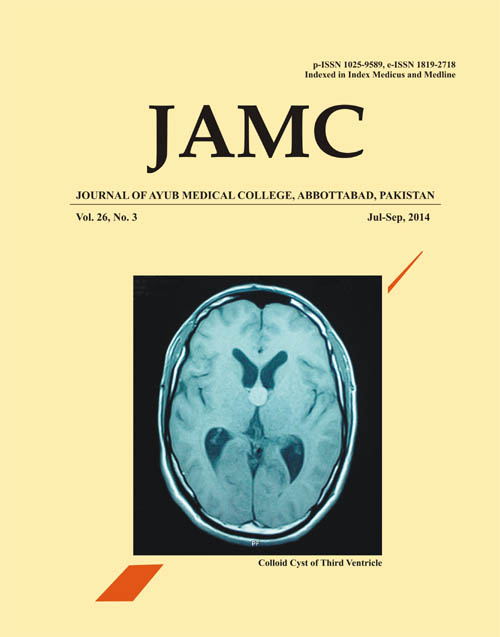SALIVARY GLAND TUMOURS: A REVIEW OF 91 CASES
Abstract
Background: Salivary gland tumours constitute heterogeneous group of tumours with different biological behaviour and account for 3% of all head and neck tumours. This study was conducted to study the clinico-pathological spectrum of salivary gland tumours. Methods: The study is a review of 91 cases of salivary gland tumours reported at Chugtai’s Lahore Laboratory from 2009-2011. The clinical data of the patients was obtained from their respective files. Results: Age range of the patients was from 8–92 years. These tumours were slightly more common in females with female to male ratio of 1.1:1. Parotid gland (51.6%) was the commonest site for the occurrence followed by minor salivary glands (27.4%). Majority (58.2%) of them were benign. Of all the benign and malignant tumours pleomorphic adenoma (47.2%) was commonest tumour followed by adenoid cystic (17.5%) and mucoepidermoid tumours (16.4%). Conclusion: These tumours are more common in females with wide range of age distribution. Parotid gland is the most common site of involvement with pleomorphic adenoma being the commonest tumour type.Keywords: Salivary gland tumours, pleomorphic adenoma, adenoid cystic carcinoma, mucoepidermoid carcinomaReferences
Arcuri F, Grivetto F, Poglio G, Brucoli M, Benech A: Simultaneous palatal pleomorphic adenoma and mandibular keratocystic odontogenic tumour in a pediatric patient. J Craniofac Surg 2011;22:2347–50.
Bell D, Hanna EY. Salivary Gland Cancers: Biology and Molecular Targets for Therapy. Curr Oncol Rep 2012;14:166–74.
Sarfraz T, Qureshi SM, Khan SS, Janjua OS, Alamgir W, Muhamma. Clinicopathological aspects of malignant salivary gland neoplasms – a study of 150 cases at AFIP, Rawalpindi (Pakistan). Pak Armed Forces Med J 2011;61:194–7.
Dyląg-Trojanowska K. Giant submandibular gland tumour: mucoepidermoid carcinoma within the pleomorphic adenoma (mixed tumour). Pol Przegl Chir 2011;83:227–30.
Arunkumar KV, Kumar S, Bansal V, Saxena S, Elhence P: Pleomorphic adenoma--unusual presentation of a salivary gland tumour in the neck of a child. Quintessence Int 2011;42:879–82.
Vuhahula EA. Salivary gland tumours in Uganda: clinical pathological study. Afr Health Sci 2004;4(1):15–23.
Speight PM, Barrett AW. Salivary gland tumours. Oral Dis 2002;8:229–40
Jones AV, Craig GT, Speight PM, Franklin CD. The range and demographics of salivary gland tumours diagnosed in a UK population. Oral Oncol 2008;44:407–17.
Gill MS, Muzaffar S, Soomro IN, Kayani N, Hussainy AS, Pervez S, et al. Morphological Pattern of Salivary Gland Tumours. J Pak Med Assoc 2001;51:343–6.
Gbotolorun OM, Arotiba GT, Effiom OA, Omitola OG. Minor salivary gland tumours in a Nigerian hospital: a retrospective review of 146 cases. Odontostomatol Trop 2008; 31(123):17–23.
Lopes MA, Kowalski LP, da Cunha Santos G, Paes de Almeida O. A clinicopathologic study of 196 intraoral minor salivary gland tumours. J Oral Pathol Med. 1999;28:264–7.
McHugh CH, Roberts DB, El-Naggar AK, Hanna EY, Garden AS, Kies MS, et al. Prognostic factors in mucoepidermoid carcinoma of the salivary glands. Cancer 2012;118:3928–36.
Rahman B, Mamoon N, Jamal S, Zaib N, Luqman M, Mushtaq S, et al. Malignant tumours of the minor salivary glands in northern Pakistan: a clinicopathological study. 2008;1(2):90–3.
Ladeinde AL, Adeyemo WL, Ogunlewe MO, Ajayi OF, Omitola OG. Salivary gland tumours: a 15-year review at the Dental Centre Lagos University Teaching Hospital. Afr J Med Med Sci. 2007;36:299–304
Published
Issue
Section
License
Journal of Ayub Medical College, Abbottabad is an OPEN ACCESS JOURNAL which means that all content is FREELY available without charge to all users whether registered with the journal or not. The work published by J Ayub Med Coll Abbottabad is licensed and distributed under the creative commons License CC BY ND Attribution-NoDerivs. Material printed in this journal is OPEN to access, and are FREE for use in academic and research work with proper citation. J Ayub Med Coll Abbottabad accepts only original material for publication with the understanding that except for abstracts, no part of the data has been published or will be submitted for publication elsewhere before appearing in J Ayub Med Coll Abbottabad. The Editorial Board of J Ayub Med Coll Abbottabad makes every effort to ensure the accuracy and authenticity of material printed in J Ayub Med Coll Abbottabad. However, conclusions and statements expressed are views of the authors and do not reflect the opinion/policy of J Ayub Med Coll Abbottabad or the Editorial Board.
USERS are allowed to read, download, copy, distribute, print, search, or link to the full texts of the articles, or use them for any other lawful purpose, without asking prior permission from the publisher or the author. This is in accordance with the BOAI definition of open access.
AUTHORS retain the rights of free downloading/unlimited e-print of full text and sharing/disseminating the article without any restriction, by any means including twitter, scholarly collaboration networks such as ResearchGate, Academia.eu, and social media sites such as Twitter, LinkedIn, Google Scholar and any other professional or academic networking site.









